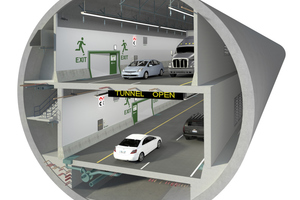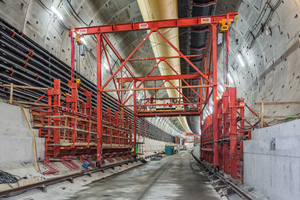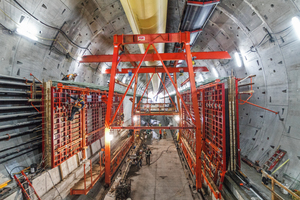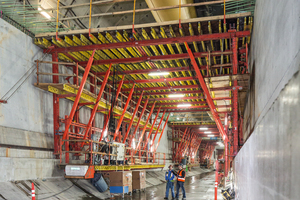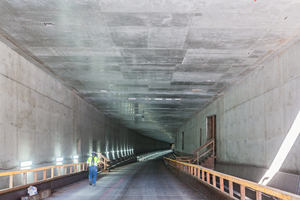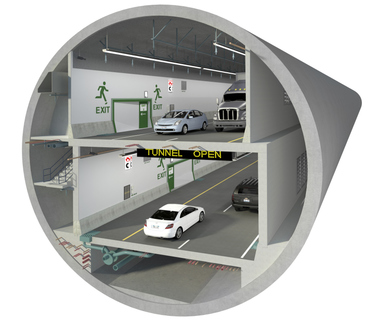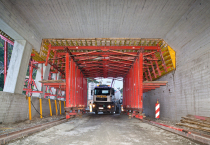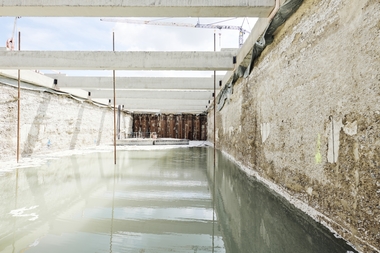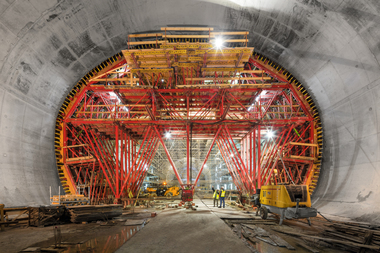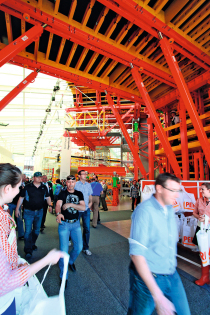State Route 99 Tunnel: Formwork Solution for Double-Deck Tunnel
The 1950s vintage Alaskan Way Viaduct has long been considered one of the most important thoroughfares along Seattle's waterfront in Washington, USA. As a replacement for the elevated viaduct that is used daily by 110 000 vehicles, a 3.2 km long tunnel is currently being constructed. Peri planned and delivered a project-specific formwork solution for the realization of the double-deck carriageway whereby the previously bored tunnel tube length is being concreted in three sections each time.
A Replacement for the Alaskan Way Viaduct
After the Alaskan Way Viaduct had suffered considerable damage due to a major earthquake in 2001, initial preparations were made for a replacement. Eight years later, plans for a bored tunnel emerged. In 2011, Seattle Tunnel Partners (STP) was awarded the contract for the design and construction of the tunnel – a joint venture of the Tutor Perini Corporation from California and Dragados USA.
Bertha, one of the world's largest tunnel boring machines (TBM) excavated a tunnel with a diameter of around 17.50 m was then directly lined with 60 cm thick precast concrete ring segments. Inside the tube, a double-deck carriageway is realized (Fig. 1). The required walls as well as the supported tunnel slab are being formed by means of mobile formwork solutions from Peri.
The Requirement: mobile Formwork Carriage on Rails
The task for Peri engineers was to develop mobile formwork solutions in order to efficiently shutter and concrete the reinforced concrete construction within the circular tunnel tube, and to move the carriage to the next section. Execution is divided into three construction phases, namely corbels, side walls and slab. The slab subsequently forms the upper carriageway. There are also cast-in-place walls above the elevated slab formed with Peri Domino.
For the planning, the Peri team had to take into consideration a wide range of boundary conditions, which included the numerous tunnel curves as well as the required lateral inclinations of the slabs. As all TBM formwork carriages are designed to be moved along one and the same rail construction through the entire tunnel, specific planning of the concreting sections was particularly important for ensuring efficient implementation. Logistics also had to be taken into account: because the TBM had to be constantly supplied with materials such as the concrete ring segments, the overall concept had to include a sufficiently large passageway. The formwork carriages were eventually designed to accommodate 16.45 m long sections – based on the expected average advance rate of the tunnel boring machine.
The Execution Solution
Initially, the construction team levelled the floor of the tunnel with a layer of concrete on which rails were installed for moving the corbel formwork carriage. In addition, a flat working surface was created in this way for the starting unit that forms the foundation of the entire construction.
The first carriage directly following the TBM carries the side formwork of the starting unit – one formwork set per tunnel side (Fig. 2). The corbel formwork was custom steel formwork. Maximo came in after to form the walls. Rails for the wall and slab travellers are on top of the corbel.
On the one hand, the starting unit forms the foundation for the rising side walls of the inner tunnel. On the other, it also subsequently serves as a support for the prefabricated panels that are installed as the bottom carriageway slab after the in-situ concrete work has been finally completed.
After the foundations have reached the required minimum strength, the 4.50 m high side walls of the inner tunnel are concreted directly on the starters (Fig. 3). For this purpose, two formwork sets consisting of Maximo panel formwork are used, which are moved from concreting section to concreting section on a second formwork carriage. While one set of formwork remains in the rear tunnel section after the concrete has been placed, the second formwork set is reassembled further ahead in the tunnel after striking.
In the third construction phase, a slab is constructed that subsequently forms the carriageway which will carry southbound traffic. The slab is realized with a total of six slab formwork carriages, using the back-step construction method (Fig. 4): three slightly longer carriages with project-specific formwork on the basis of Variokit steel walers and GT 24 formwork girders serve to carry out concreting in advance for the slab sections. The resulting interstitial spaces are subsequently closed by means of three slightly shorter slab formwork carriages.
TBM finished Excavation Works on April 21
Through the close cooperation of all parties involved along with early planning, a coherent overall concept for allowing efficient construction of this complex structure was developed and implemented. Due to the fact that most of the system components used have been supplied from the Peri rental park, the formwork solution has also been very cost-effective. In particular, the use of system components from the Variokit engineering construction kit enables the construction team to meet the strict schedules for all formwork operations as well as the required geometrical adaptations in spite of the less-than-favourable conditions. In addition, the use of hydraulic solutions for shuttering and striking in certain areas facilitates faster working. The travelers also are advanced hydraulically.
As of spring 2017, the southbound roadway deck stretched beyond the tunnel’s halfway point. On April 21, TBM Bertha completed her journey and is now being cut into pieces and removed from the disassembly pit.

